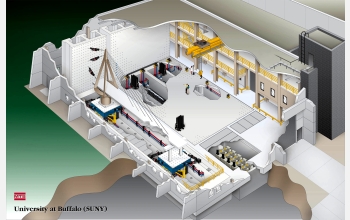Multimedia Gallery
Dual shake table at UB's earthquake simulation lab
The dual shake table located at the University at Buffalo's (UB) Structural Engineering and Earthquake Simulation Laboratory. Shake tables help researchers understand how very large structures react to a wide range of seismic activity.
The Structural Engineering and Earthquake Simulation Laboratory at UB will be a key node in a nationwide earthquake engineering "collaboratory"--the George E. Brown, Jr. Network for Earthquake Engineering Simulation (NEES). The network involves earthquake engineers and students located at different institutions sharing resources, collaborating on testing and exploiting new computational technologies. The goal of UB's NEES node project is to develop the most versatile earthquake engineering research facility possible, providing testing capabilities that will revolutionize the understanding of how very large structures react to a wide range of seismic activity, even when tested to complete failure. One new technique UB will explore is called real-time dynamic hybrid testing in which shake table and/or dynamic force experiments on substructures are combined in real time with computer simulations of the remainder of the structure. This will provide a more complete picture of how earthquakes would affect large structures without the need to physically test the entire structure.
The testing facility was developed with support from the National Science Foundation (grants CMS 00-86611 and CMS 00-86612), ICMS and the NEES program. [See related image Here.] (Year of image: 2001)
Credit: Courtesy University at Buffalo and MTS Systems Corporation
Images and other media in the National Science Foundation Multimedia Gallery are available for use in print and electronic material by NSF employees, members of the media, university staff, teachers and the general public. All media in the gallery are intended for personal, educational and nonprofit/non-commercial use only.
Images credited to the National Science Foundation, a federal agency, are in the public domain. The images were created by employees of the United States Government as part of their official duties or prepared by contractors as "works for hire" for NSF. You may freely use NSF-credited images and, at your discretion, credit NSF with a "Courtesy: National Science Foundation" notation.
Additional information about general usage can be found in Conditions.
Also Available:
Download the high-resolution JPG version of the image. (1.5 MB)
Use your mouse to right-click (Mac users may need to Ctrl-click) the link above and choose the option that will save the file or target to your computer.



